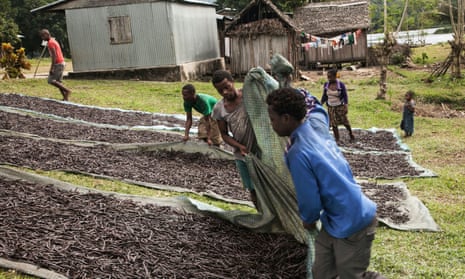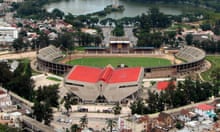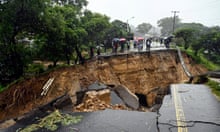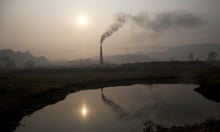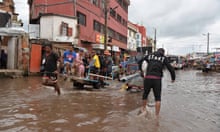Nine-year-old Xidollien has no idea that the vanilla pods he and his family so painstakingly cultivate throughout the year on their small vanilla farm in the north of Madagascar is one of the most valuable spices in the world.
He hides behind his mother, Liliane, as she stands among the family’s vanilla plants . He has spent all morning clearing weeds from the land with a machete. Tomorrow will be the same for him and thousands of other children in the northern region of the island.
Roughly 80% of the vanilla sold on the global market comes from Madagascar. Madagascan vanilla is used in chocolate, cakes and ice-cream sold to consumers around the globe by some of the world’s biggest brands.
Yet, according to a new report by research and media centre Danwatch, the vanilla supply chain is keeping farmers like Xidollien and his family locked in a cycle of exploitation, poverty and child labour.
In small communities in Madagascar’s Sava region, the heavy workload involved in growing vanilla and the poor price that farmers receive for their pods mean child labour is often a necessity. Malnutrition and child stunting are realities of family life.
Vanilla is the second most expensive spice in the world. Prices fluctuate, but industry reports show the commodity is currently selling at between $200 (£160) and $400 a kilo. Xidollien’s mother, Liliane, gets just £6 a kilo for the family’s vanilla pods from the “collectors”, young men on motorbikes who come to the village to buy the pods after each harvest. She has no idea where her crop ends up. “I sell to a collector. When it goes, it’s gone,” she says with a shrug.
Rajao Jean, president of a local farmers’ association, says that when farmers become desperate for food during the long wet months, the same collectors return to offer a “vanilla flower contract” – loans to see them through to harvest. The collectors fix the price and return after harvest to collect their debt and the high interest it has accrued, buying the pods far below market value.

Jean says that if farmers have a bad harvest or have their plants stolen, they can be forced to sell land, animals and possessions in an attempt to pay off this debt. He explains that a loan of £1 in March could have escalated to £10 by harvest time in July.
The Danwatch report claims that the plight of Madagascan farmers has been largely ignored by exporters and retailers profiting from the $192m (£152m) trade in Madagascan vanilla.
“The farmers are making a scarce profit,” says Jesper Nymark, executive director of Danwatch, adding that the investigation reveals a lack of traceability and transparency in supply chains. “Several of the importers and retailers we have spoken with are not able to say which specific farms their vanilla comes from, and whether there is vanilla in their supply chain that has been produced by children.”
The International Labour Organisation estimates 20,000 children are working in the Madagascan vanilla trade, the majority of them in the Sava region. The country has ratified international child labour conventions and set a minimum working age of 15, but the ILO says there are 2 million children between the ages of five and 17 engaged in various forms of work on the island; nearly 9% of the total population.

Liliane desperately wants Xidollien and his 14-year-old brother to get out of vanilla farming. “I would love for them to have an education, but I don’t know if it’s possible,” she says.
She explains that while her oldest son, Yokle, pollinates the vanilla flowers, Xidollien spends the day weeding the field. After a hot morning of work she can only afford to feed her children a meal of boiled sweet potatoes and water from the muddy stream that runs through their field.
Many here don’t consider children working alongside their parents as a problem. Tombo Tam Hun Man, 63, former mayor and now local vanilla kingpin in Andapa, one of the main towns in the vanilla-producing region, says that children helping in the fields is a natural way for them to learn about vanilla farming.
Under Madagascan law, children must go to school until they are 14, but he admits that few children in the vanilla villages will get an education.
“If you don’t start to teach your kids to do something, what will they do? It is better than nothing,” he says. With few government schools, private fee-paying schools are often the only option for farming families. There is no visible evidence of any infrastructure or investment in the vanilla communities by any of the exporters or retailers using Madagascan vanilla pods.
The Madagascan authorities have attempted to regulate the vanilla trade, introducing a code of conduct in 2015. However, resources to implement the code are insufficient, says Bety Florent, president of the regional child labour committee. “We are still at a basic stage. There is still no effective measure,” she says, explaining that only 16 of 86 child labour committees proposed by the government have so far been set up in the region.
“Retailers and importers are obliged by UN guidelines to do whatever [is] in their power to know their supply chain, and to correct violations of human rights if they occur,” says Nymark. “According to the experts we have talked to, there seems to be quite the task ahead in ensuring that people in Madagascar are supported, not exploited, as a consequence of the lack of transparency in the supply chain for the vanilla sold in local supermarkets.”
Jean spent his childhood in the vanilla fields and hopes his children will have a different life. Yet next March the vanilla collectors will be back in the village, offering loans and making deals. For some farmers, the cycle will start all over again.
